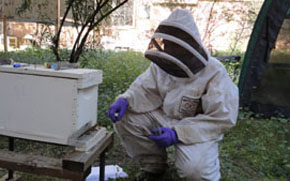

Researchers uncover influence of genetic elements on physiological and behavioral changes in Apis mellifera
Researchers uncover influence of genetic elements on physiological and behavioral changes in Apis mellifera.
Researchers uncover influence of genetic elements on physiological and behavioral changes in Apis mellifera.

Researchers uncover influence of genetic elements on physiological and behavioral changes in Apis mellifera
By Noêmia Lopes
Agência FAPESP – For many decades, scientists have known that the diverse characteristics of bees are influenced by vitellogenin. This protein is produced in the fat bodies (tissues below the epidermis), whose functions are associated with the nutrition of embryos and the hormonal regulation, immunity and longevity of worker bees.
The levels of vitellogenin in fat bodies indicate the changes in activity that worker bees experience throughout their lives. While the bees are working in the colony, feeding the brood, vitellogenin expression is high. As the bees advance in age, vitellogenin levels diminish, and the bees become field bees, which forage for nectar, water and resin in the external environment.
A recent study at the School of Philosophy, Sciences and Letters at Universidade de São Paulo in Ribeirão Preto (FFCLRP/USP) was the first to discover that there are other factors involved in the transformation of worker bees into field bees.
“We discovered that the reduction in vitellogenin in the fat body is concomitant with its diminishment in another organ: the brain. And [we discovered] that that drop in both regions is connected to the expression of microRNAs, or small RNAs that regulate the levels of messenger RNA in cells,” explained Francis Nunes, at the time of his post-doctoral studies in the Department of Biology at FFCLRP/USP. Nunes is currently a professor in the Department of Genetics and Evolution at Universidade Federal de São Carlos (UFSCar).
In this manner, the team proved that behavioral changes of bees depend on communication between the brain and the fat body and on vitellogenin levels and microRNA expression in these organs. These body components are connected – as if forming a network – and act in concert, allowing precise genetic and physiological regulation of several activities performed by worker bees.
“It is still early to speak about practical applications. Even so, these discoveries advance our understanding of the molecules that affect the social behavior of bees and our understanding of complex biological characteristics, such as aging,” stated Nunes.
The results were published in June in the article The gene vitellogenin affects microRNA regulation in honey bee (Apis mellifera) fat body and brain, published in The Journal of Experimental Biology. The findings are the fruit of two projects on genetic networks in bees: Regulator and functional networks associated with expression of the vitellogenin gene codifier in Apis mellifera castes, for which Nunes received a FAPESP Post-Doctoral Fellowship, and Causal analysis of the Develop of Apis mellifera – regulator genes and hierarchical networks of gene expression in tissue and organ specification, a FAPESP Thematic Project coordinated by Zilá Simões, a professor in the Biology Department at FFCLRP/USP and the co-author of the study.
Development of the studies
Environmental factors, such as food or the death of the queen, can also alter vitellogenin expression in worker bees and, consequently, the social organization of the colony. “In our experiments, we artificially induced the alteration [in vitellogenin expression] using an RNA interference technique,” explained Nunes. This technique consists of injecting double-stranded RNA into two groups of bees, with one group receiving RNA that silences vitellogenin expression (Group Vg-), and the other receiving a non-silencing RNA and therefore serving as the control group (Group Vg+).
Afterward, analysis using a method known as microarrangements of microRNAs indicated which microRNAs respond positively or negatively to the silencing of vitellogenin in both the brain and the fat body. According to Nunes, “we observed which microRNAs react to genetic silencing in two distinct organs: one cognitive center and one metabolic center. Together, these molecular changes cause physiological changes that culminate in the early aging of worker bees, which turned into field bees earlier.”
The bees were observed daily. At fifteen days, almost all of the bees in Group Vg- were foraging, whereas the foraging activity was far less intense in the control group (Vg+).
Next, the team intends to investigate the changes in vitellogenin expression through artificial diets.
Kate Ihle, Navdeep Mutti and Gro Amdam, researchers from Arizona State University, participated in the two studies.
Republish
The Agency FAPESP licenses news via Creative Commons (CC-BY-NC-ND) so that they can be republished free of charge and in a simple way by other digital or printed vehicles. Agência FAPESP must be credited as the source of the content being republished and the name of the reporter (if any) must be attributed. Using the HMTL button below allows compliance with these rules, detailed in Digital Republishing Policy FAPESP.




